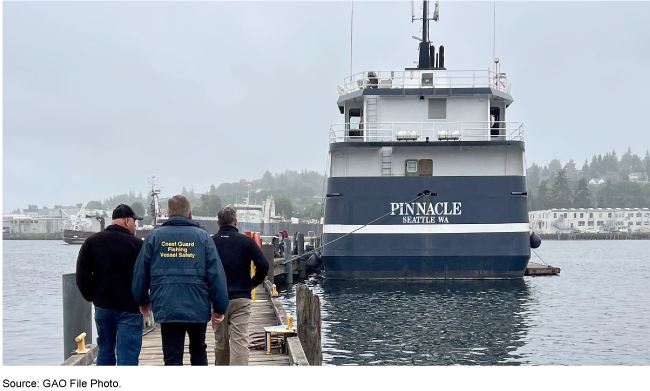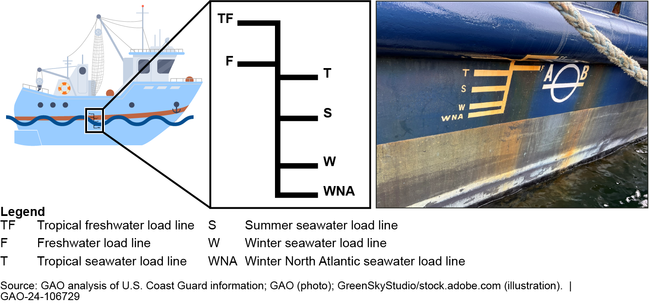Coast Guard: Enhanced Safety Oversight Needed for Fish Tender Vessels
Fast Facts
"Fish tenders" are commercial boats that transport fish among fishing boats and processing facilities. To help prevent capsizing, some fish tenders must meet "load line" requirements. These rules help ensure safety and prevent overloading in different water conditions.
In 2015, the Coast Guard realized that it had mistakenly not enforced these requirements for some part-time fish tenders in Alaska and the Pacific Northwest. In 2018, it proposed creating an alternative program to exempt them if they meet other safety measures.
Among other things, we recommended that the Coast Guard assess if the program poses safety risks before implementing it.
Coast Guard fishing vessel safety examiners prepare to start an exam in Seattle, Washington, in 2023.

Highlights
What GAO Found
Under U.S. law, certain fish tender vessels are subject to load line and stability requirements to ensure their safety in different waters, including by reducing their likelihood of capsizing.
- A fish tender vessel supplies and transports fish from a catcher vessel to a processing facility.
- A load line ensures a vessel's overall seaworthiness and includes maintaining certain structural features such as watertight closures.
Example of Load Line Markings on a Fish Tender Vessel

The Coast Guard's data system captures information on the activities of commercial fishing industry vessels but does not capture data on vessels engaging in multiple service types, such as both catching and tendering fish. As a result, the Coast Guard is unable to generate a reliable list of fish tender vessels to identify which vessels are subject to load line requirements and the extent they have been in accidents. By assessing the feasibility of updating its system to capture multiple service types, the Coast Guard will be better positioned to oversee fish tender vessels.
In 2015, the Coast Guard recognized that some vessels that were operating as part-time fish tender vessels were not in compliance with load line requirements. In August 2019, the Coast Guard created a task force that proposed an alternative compliance program that would exempt certain fish tender vessels from load line requirements while still providing an appropriate level of oversight. The task force paused its work after May 2022 without (1) fully assessing the safety risks posed to vessels participating in such a program, and (2) clearly identifying the proposed program's legal basis. Should the Coast Guard pursue implementation of a program, fully assessing the safety risks posed to fish tender vessels without a load line can help it ensure that any proposed alternative compliance program maximizes vessel safety within existing resource limitations. By clearly identifying a legal basis for the program, the Coast Guard can better ensure that any proposed program is consistent with its legal authorities.
Why GAO Did This Study
Commercial fishing is an important part of the economy, yet one of the most hazardous occupations in the U.S. The U.S. Coast Guard is the primary federal agency responsible for marine safety, which includes enforcing safety requirements for fish tender vessels.
The James M. Inhofe National Defense Authorization Act for Fiscal Year 2023 includes a provision for GAO to review issues related to load line requirements for fish tender vessels. This report addresses: (1) the load line and stability requirements for fish tender vessels; and the extent the Coast Guard (2) collected data on the activities of commercial fishing industry vessels in Alaska and the Pacific Northwest as they pertain to tendering and what its data show, and (3) addressed fish tender vessel noncompliance with load line requirements.
GAO assessed relevant statutes, regulations, and Coast Guard documentation and data; and interviewed officials from the Coast Guard and commercial fishing industry (such as seafood companies and industry associations).
Recommendations
GAO is recommending the Coast Guard (1) assess the feasibility of updating its system of record for commercial fishing industry vessels to capture multiple service types, (2) fully assess safety risks posed to fish tender vessels participating in any proposed alternative compliance program, and (3) clearly identify the program's legal basis. The Department of Homeland Security concurred with these recommendations.
Recommendations for Executive Action
| Agency Affected | Recommendation | Status |
|---|---|---|
| United States Coast Guard | The Deputy Commandant for Mission Support should assess the feasibility of updating the Coast Guard's system of record for commercial fishing industry vessels to capture multiple service types for commercial fishing industry vessels and, if feasible, implement the changes. (Recommendation 1) |
The Department of Homeland Security (DHS) concurred with our recommendation. In January 2024, DHS officials stated that the U.S. Coast Guard's Marine Information for Safety and Law Enforcement (MISLE) system, its system of record for commercial fishing industry vessels, is undergoing a multi-year modernization project and the service will assess the feasibility of implementing this recommendation as a part of this effort. In January 2025, DHS officials stated the Coast Guard added a note field to MISLE in the interim to capture multiple service types for these vessels that is displayed on the vessel's profile. These officials stated the Coast Guard anticipates completing the multi-year MISLE modernization project in December 2028. By assessing the feasibility of updating its system of record to capture multiple vessel service types and implementing the changes if feasible, the Coast Guard will be better positioned to carry out its regulatory oversight of fish tender vessel compliance with load line requirements.
|
| United States Coast Guard | The Deputy Commandant for Operations should fully assess the safety risks posed to fish tender vessels without a load line that may participate in any proposed alternative compliance program. (Recommendation 2) |
The Department of Homeland Security (DHS) concurred with our recommendation. In January 2024, DHS officials stated that the U.S. Coast Guard is planning to finalize an assessment of fish tender vessel noncompliance with load line requirements. After this step, these officials stated the Coast Guard will then evaluate risks to fish tender vessels without a load line. In January 2025, DHS officials stated the Coast Guard is in the process of finalizing the first step of its review process-its assessment of fish tender vessel noncompliance with load line requirements. These officials stated the Coast Guard anticipates completing both steps of its process in July 2026. By fully assessing the safety risks posed to fish tender vessels without a load line, the Coast Guard can help ensure that any proposed alternative compliance program maximizes vessel safety within existing resource limitations.
|
| United States Coast Guard | The Deputy Commandant for Operations should clearly identify the legal basis for any proposed alternative compliance program for fish tender vessels without a load line. (Recommendation 3) |
The Department of Homeland Security (DHS) concurred with our recommendation. In January 2024, DHS officials stated that the U.S. Coast Guard is planning to finalize an assessment of fish tender vessel noncompliance with load line requirements. After this step, these officials stated the Coast Guard will then evaluate the service's legal authorities to develop an alternative compliance program. In January 2025, DHS officials stated the Coast Guard is in the process of finalizing the first step of its review process-its assessment of fish tender vessel noncompliance with load line requirements. These officials stated the Coast Guard anticipates completing both steps of its process in December 2025. By clearly identifying a legal basis for the program, the Coast Guard can ensure that any proposed program is consistent with its legal authorities regarding exemptions from load line requirements.
|
